Review GSM phone Samsung D810
Samsung
D810. Live pictures >>
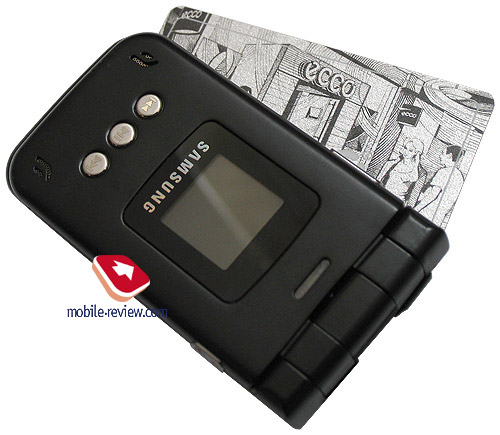
I would like to stress that this model will be available only on few markets to anticipate your disappointed questions after reading the whole review. The reason is even the Samsung's line is rich with similar models, and the discussed representative has a direct rival in the person of Samsung Z540. At the same time this model supports 3G networks. For instance, the D810 won't appear on the Russian market, which is quite logical.
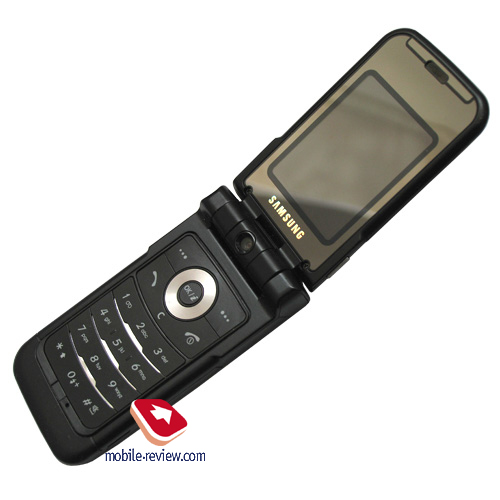
Despite some software changes (the absence of Picsel Viewer and TV-out) basically the D810 is built on the D800. Its main goal is to compete with all slim clamshells and the first target is the original RAZR. However the task seems hard for the market is filled with solutions like Motorola V3i and LG P7200. Samsung D810 and the latter model have something in common; we mean buttons to control an mp3 player placed on the face panel. The release of the Samsung's model was a bit delayed and we can say the device won't attract many customers for it lacks memory card support, which is necessary today.
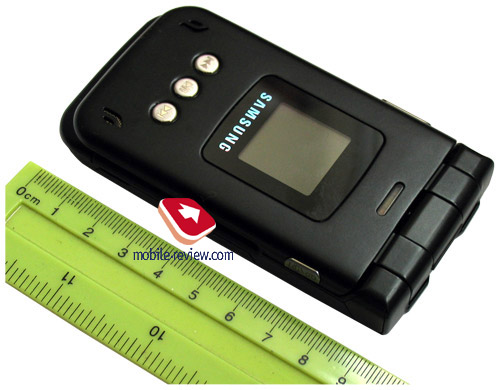
The phone is black, and this is basically the colour of the season by Samsung. All its innovations are black. That seems Korean designers always keep one certain colour. First that was silvery and now it is replaced with black. The phone size is comparable with the RAZR - 98x51x15 mm, the weight forms 96 g. This model is partly made of metal (the back and the face panels). With such a comfortable size, this handset will suit both men and women.

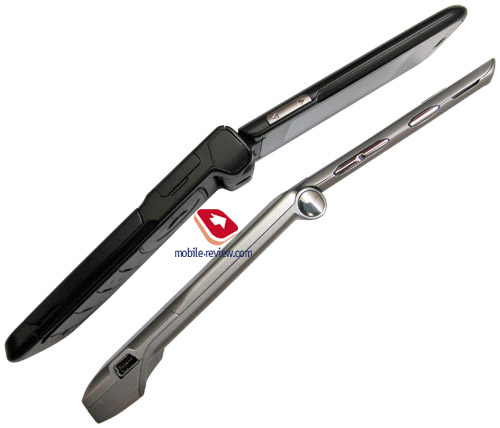

A rotary 1.3 MP camera module is on the top. A curious thing is a user can rotate the camera as he/she likes. However in a default position (with an objective directed at you in a closed mode), it will always open when opening the handset. Mechanically, the trick is quite plain, however was not widely applied in phones till today. Also the external panel features a flash, which may come handy in the dark.

The external TFT screen shows up to 262K and has the resolution of 96x96 pixels. You will surely make out the picture in any condition, certainly it is not the same in the sun due to the size of the matrix (18x18 mm), however the data remains visible. Due to the screen resolution the photo mainly corresponds with a picture, but not an abstract work of some unknown artist.

Buttons responsible for the mp3 player are under the screen. They help to control the player when the phone is closed. That seems interesting till you do not consider the absence of memory cards.
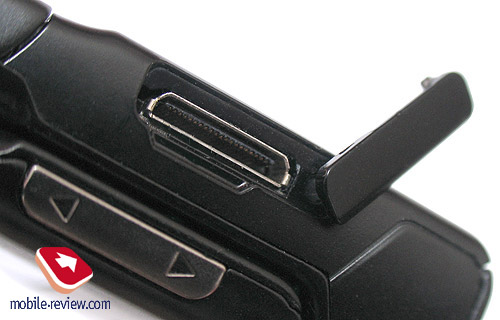
A coupled volume button found room on the left facet. A charger connecter with a plastic shutter fixed to the body joins it nearby. A headset connects through the same slot. The right facet holds the camera button and a button responsible for voice functions. Also a strap hole features the top end.
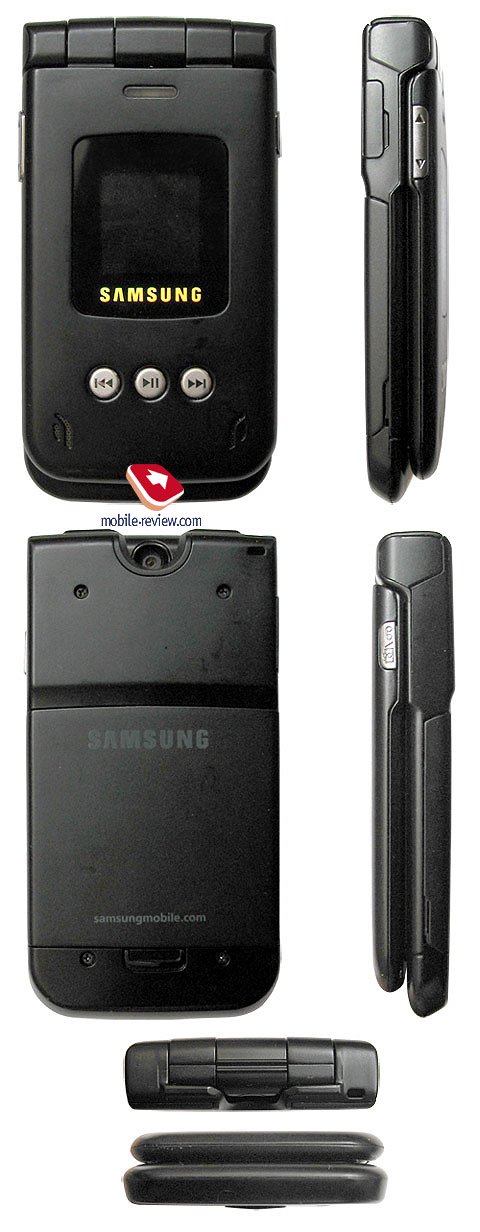
You will find it easy to open the handset with one hand, and then you will see a large screen with a mirror edging around it inside. This surface gets dirty extremely fast, however looks very pleasantly from the design point of view.
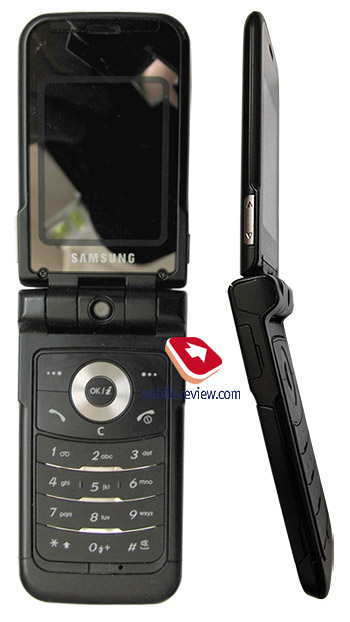
The screen is QVGA with the resolution of 240x320 pixels (33x44 mm), 2". It can show up to 262K. Being the company's development, the display characteristics appear quite good. The picture is vivid, very bright, and behaves excellently in the sun.
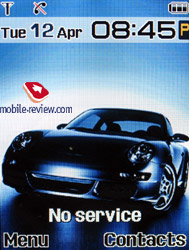
Keypad. The phone uses one plate for all buttons and contacts are placed under it. You have to press the plate hard to make the phone process the action. No key motion, you like press an even surface. However big arms will only bring problems, then you will have to press with a tip or a nail (then you can damage the keypad dramatically).
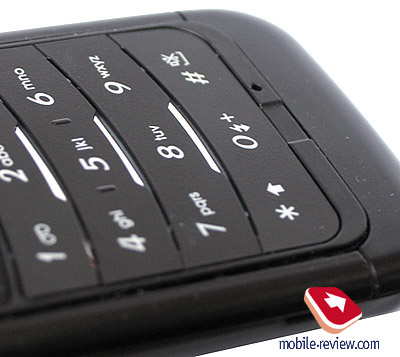
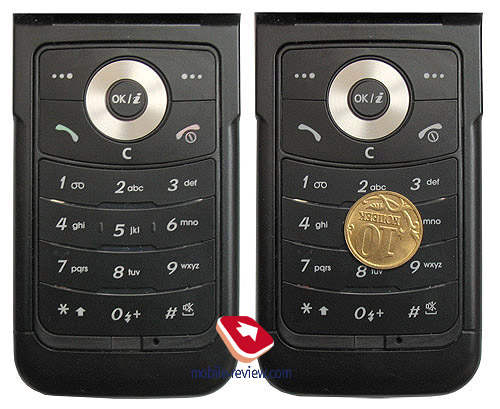
The keypad equals the one in Samsung D800. The white backlighting is not very bright, however behaves well in the dark, it is comfortable enough.
The capacity of the integrated Li-Ion battery is 800 mAh. According to the manufacturer the battery is capable of 180 hours in the standby mode and up to3 hours in the talk mode. In Moscow networks the phone worked averagely for 2 days with one hour of talks and up to 20 minutes of using other functions. If you speak little, you may have the phone alive for about three days. Recharging will take you about 1.5 hours.
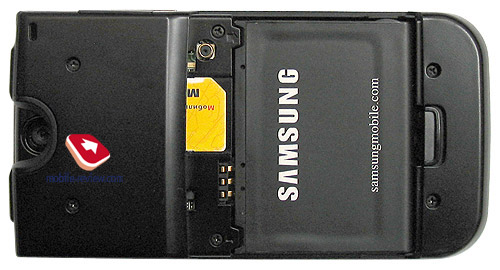
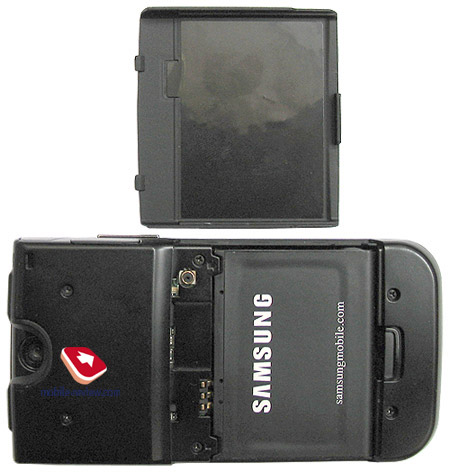
Menu
The main menu is represented in the only way - as a matrix of icons. All submenus are lists. You can select of a list of functions to assign to the navi button. In general, the menu division seemed quite logical, navigation brings no problems.
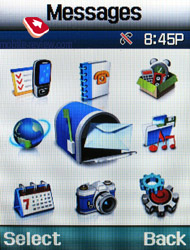
Phonebook. By pressing the right soft key, one can obtain the contacts in a form of a list containing all the files both from the phone's and the SIM-card memory. The first name in the list is backlit by default and the number is shown in the status bar (there is a special sign for numbers from a SIM-card). There is a fast search by first letters of a name; the phone can hold more than twenty of those for any possible language. By pressing the OK key, you enter in the view menu of a single file where you may see a small icon in case the name is matched with the image. Any graphic file or the pictures of your own may be used as such image. Up to five phone numbers of various types (cell, office, home, fax, other) may be kept for a name with one number as the main contact (it would become the first one by default). The fields are strictly fixed and there may be not two cell phone numbers entered. On the other hand, SMS/MMS can be sent to any number from the phone book once chosen.

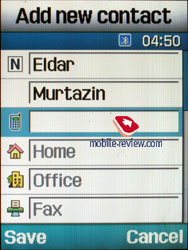


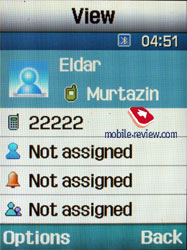
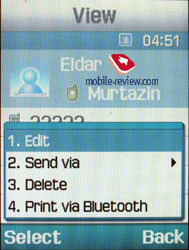
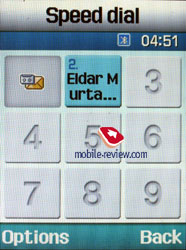
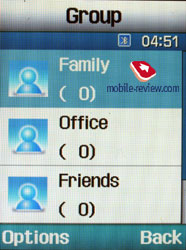
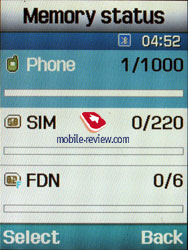
There are two fields for a Name and a Surname (search only by the first one) that are concatenated when displayed and the Name field goes the first. For example, if you entered Eldar Murtazin, it is displayed exactly in this manner. The length of each line is 20 symbols for any of the available languages. You may opt to alter the language while inserting the text as well.
Files in different languages are sorted out according to a rule - first it will be all files in the local language (Russian, for example), and then those in English. This is rather convenient and habitual by the example of computer programs. Taking into account an option of fast language change during the search, it becomes clear that the files in different languages do not impede the work with this phone.
Let us return to the information entered for one name. Besides phone numbers, an e-mail address and a little text memo can be recorded. Any music file as well as composed MP3's can be chosen as a ring tone for the name. Three caller groups are preinstalled and out of any category. You can easily create a necessary number of groups, select a personal melody and image for each.
Up to 1000 names with all the data can be saved in the phone's memory. Even if all the available lines are not used, the number of names to be saved would remain a thousand. It is possible to indicate in the settings where the new numbers should be kept by default. There is an option of moving files from the SIM-card although not vice versa. According to the developers, PC is the best means of synchronization, MS Outlook in particular. Any file in the form of SMS/MMS, mail message or other text file can be sent quickly through Bluetooth to another device. There are no problems with sending and the phone book entry being transmitted to another device is precisely decoded without any trouble.
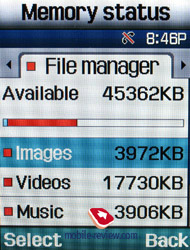
New names can be entered only through the main menu; the right soft key always calls for the name list only. You can create your own visit card; its format would be the one of a regular file from the phone book.
There can be up to eight numbers in the speed dial list; peculiar is the fact that separate numbers of one name may be in this list as well. The subtitle of the chosen name (but not of the phone type) is displayed on the buttons.
When receiving a call, a picture is displayed not full screen, but on a part of it, however takes a considerable area.
Call lists. Up to thirty phone numbers are displayed in each list. There is a combined list of all the last calls with an icon indicating a call type. Tilting the scroll key horizontally, you may switch quickly from one list to another. The date and the time of the call (it's duration is not kept) can be seen for separate files. Calls from/to one number are summarized and a number against the call specifies the number of calls. Time for each of them can be obtained in detail menu. As always, the overall time of the calls and their prices can be viewed in this menu (this service has to be installed).

Messages. Working with different types of messages is done through separate submenus. Let us begin with short messages. Up to 200 messages can be saved in the phone's memory; the phone supports the EMS standard compatible with Nokia Smart Messaging. T9 functions very well and is quick and easy to use.
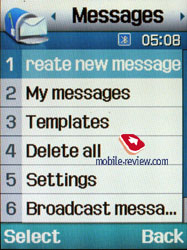
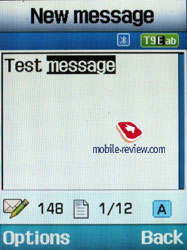

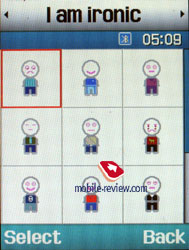

MMS. The interface for multimedia messages is very nice; the messages can be saved in several folders at once and right away. There are no size restrictions for a message to be received although a message should not exceed 295 KB. As for additional services, the rejection of advertising messages, the option of the message receipt in the roaming and the home network should be mentioned. The messages are saved in the general memory since there is no special memory for them.
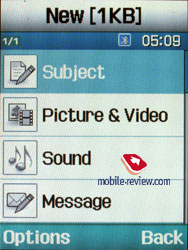
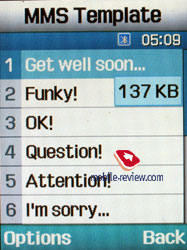
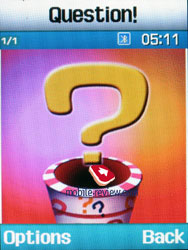

Organizer. Up to 400 events of four types - meeting, affair, anniversary and others, can be saved in the phone's memory. The day and the time as well as its end are indicated for each file. A signal can be set for the interval during which it has to go off; repetitive events are available for setting. The weekly and the monthly calendar are very convenient with each type of the event having its own color.
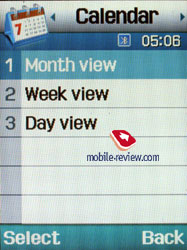


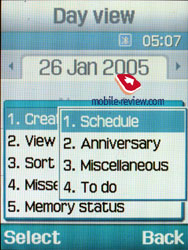
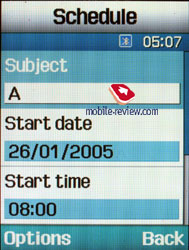
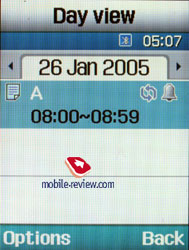
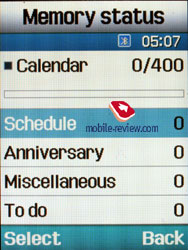
WAP. There is a wap-browser version 2.0 similar to some phones by Nokia and Sony Ericsson using http protocol. That means in some networks operator's setting is required.

Applications. MP3 player. An integrated mp3 player supporting accidental track reproduction, both sequential and cyclic, is available in the phone. Mp3 files can be downloaded into the phone both directly through Bluetooth and through a synchronization program. Files may be of various names and tags (in Russian language as well!). The bit rate of the files is not that important since the phone accepts all the possible formats.
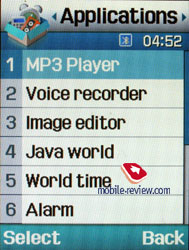
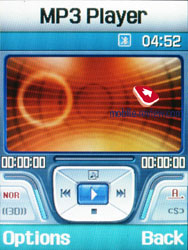
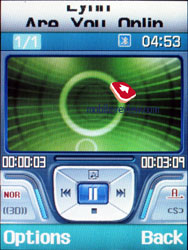

Sound transfer to Bluetooth stereo headphones is an unordinary capability. The latest Samsung's models come equipped with a corresponding profile.
The name of the track playing is displayed as well as the overall number of different composition. An equalizer is of an entertaining nature; there are no separate settings (only selection from classic, rock, jazz and normal). The tracks can be played through the stereo headset as well as through the speakerphone. The volume is of ten divisions. The user is welcome to create play lists of his/her own. Somewhat 76 MB of the memory are kept for the mp3 compositions. The player can work in background mode.
Dictaphone. You can record up to several hours of voice memos with the number of files being unlimited. The time restrictions for one recording are set by a user and can vary to one hour in duration. All the files are kept in a separate folder in the memory. The recorder can function well during the lectures, conferences, and presentations. The phone is a partial substitute for a digital tape recorder.
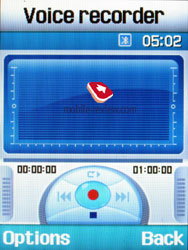

Java World. Java World is the first menu file; up to four MB of memory are available in the phone for various programs. This is a separate memory slot and is used for Java only. MIDP 2.0 version allows the use of the graphically reach and three-dimensional games. Three games, Forgotten Warrior, Freekick, and ArchAngel are offered in the phone
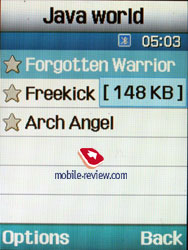
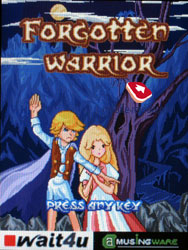
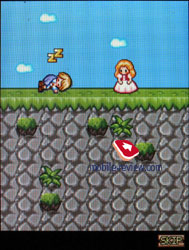
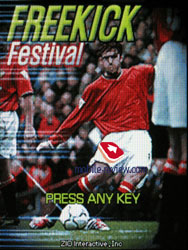
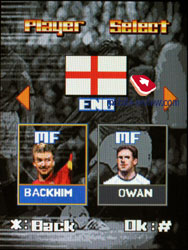

World time is displayed for two chosen cities. Everything is nice and simple here.
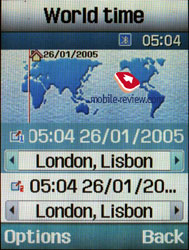
Alarm clock. The phone is equipped with three alarm clocks. One is meant for mornings and can be set for selected weekdays as well as for weekends. For each of the alarm clocks there is a selection of five melodies and mp3 compositions can be used here. It is up to a user to indicate in the settings whether the phone would turn on automatically in the time of the event or not.


Calculator. Everything is nice and simple here.

With a converter you can operate with different units of measurements as well as with the currencies.
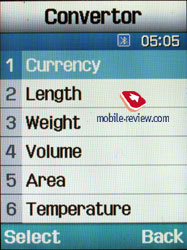
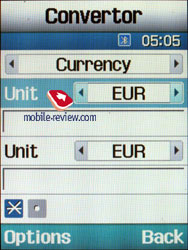
Countdown timer. The time can be displayed in both hours and minutes; the clock can be used as a background.

You can request the intermediate result with a stopwatch.

Image editor is a plain editor, which allows simple image transformations and applying effects.
Funbox. All the 'fun' files, such as music, images, videos, and sound are kept here. All the downloaded files are transmitted here. One disadvantage here is that sometimes the file is not immediately displayed in the general list and a user has to exit and open the list anew.
Settings. That is traditional that you are allowed to choose font colour in the standby mode, protect any section of the phone with a password (messages, short messages, organizer and so on). You may set the time for backlighting on and its brightness.

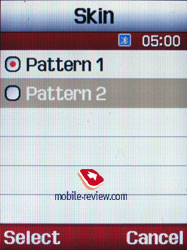
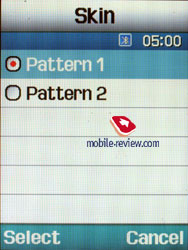
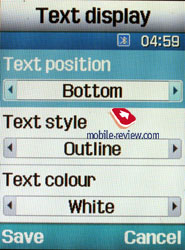
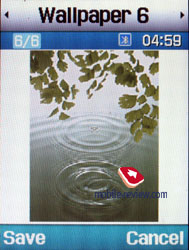
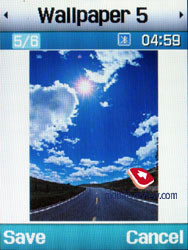
Bluetooth. The handset supports various profiles, namely, Headset, Handsfree, Serial Port, Dial Up Networking, File Transfer, Object Push, and A/V Headset. The Bluetooth realization is not ideal, often troubles with headsets having only a Headset profile appear, and work with a speakerphone is also incorrect sometimes. In general the Bluetooth is better than in Nokia phones, Siemens, but worse than in Sony Ericsson.
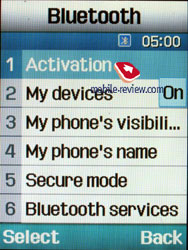

Camera. The camera module is 1.3 MP and equal to the majority of Samsung models of the last generation. The camera is typical and allows taking photos of good quality to show on the display. At the same time photos look not very qualitative on a PC screen.
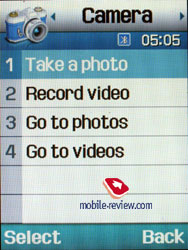



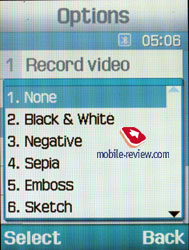

The camera works in 6 different resolutions:
- SXGA (1280x1024)
- Мега (1152x864)
- VGA (640x480)
- QVGA (320x240)
- QCIF (176x144)
- Sub- QCIF (128 x 96)
The compression quality for JPEG pictures is set separately, several types are available:
There are about 5 different sounds for a shutter and the sound may be turned off at all then taking photos won't draw everybody's attention. A default file name, the sensitivity of the matrix (Auto, ISO 100, ISO 200, ISO 400) may be set. I'd recommend using an Auto mode because it works correctly mostly. The difference between sensitivity modes is not felt in usual conditions. You won't see any changes on a real photo.
The timer for selfshooting is set for 3, 5 or 10 seconds.
The matrix mode switches the camera to the lowest resolution (a final picture is 640 x 480 pixels) and you get a picture that consists of 4 or 9 items (2x2 or 3x3). It's a curious mode that may be interesting for experiments.
In a multishooting mode it's possible to select some series, in particular that may be 6 photos with high speed (practically immediate pictures), with normal speed (the period between the photos is a second or less). Also modes with 9 and 15 photos are available. I'll note that the function is interesting as a photofinish at a competition, in real life if moving the camera the photos will be blurry in the majority of cases. The resolution is 320x240 in this mode.
Describing separate functions, we completely forgot to tell about switching into a shooting mode, which is done either by pressing a side button or via the menu. The screen of the phone serves as a viewfinder, using a navi button you may change the contrast level and use zoom. When the resolution is maximum, the zoom function is turned off automatically. The picture may be mirrored on the screen using side buttons.
|
|
 |
 |
(+)
increase, 1280x1024, JPEG |
(+)
increase, 1280x1024, JPEG |
 |
 |
(+)
increase, 1280x1024, JPEG |
(+)
increase, 1280x1024, JPEG |
 |
 |
(+)
increase, 1280x1024, JPEG |
(+)
increase, 1280x1024, JPEG |
 |
 |
(+)
increase, 1280x1024, JPEG |
(+)
increase, 1280x1024, JPEG |
 |
 |
(+)
increase, 1280x1024, JPEG |
(+)
increase, 1280x1024, JPEG |
 |
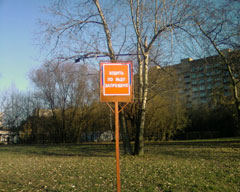 |
(+)
increase, 1280x1024, JPEG |
(+)
increase, 1280x1024, JPEG |
There is a traditional set of effects in the phone that may be applied either during a shooting process or while postediting. As for me, the second variant is more acceptable just like applying frames to the photos. We'll just name the effects and you may get acquainted with them in a separate archive (Black & White, Negative, Sepia, Emboss, Sketch, Orange, Aqua, Red focus, Yellow focus, Blue focus). The last three effects distinguish the main colors of the composition but the function is middling in the majority of cases.
The photos are kept in an album and here you may view the data on a certain photo (not above the photo as in previous models). The list is formed fast and indicates the phone name and a small icon. Any photo may be assigned to a name in the phone book or set as wallpaper just from the album menu. There is a slide show mode, a plain editor that allows adding emotion icons, apply frames and effects to the photos.
The phone records 3GP video and you may choose recording with sound or without it. All the settings are comparable with similar for photos, the same 3 quality levels but the resolutions are different. The maximum resolution forms 355x288 pixels.
There is no any limit on the duration of the record and everything depends on the free memory. Specially for MMS a recording mode that doesn't allow to exceed 100 KB is provided.
Video sample (1.71 MB)
Synchronization with PC. Synchronization is made using Bluetooth and a cable. Easy Studio 3.0 is provided on the manufacturer's site.
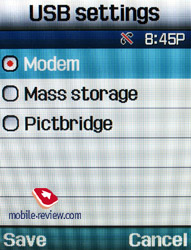
Impressions
The connection quality is high and rouses no complaints, which is typical of modern phones. The loudspeaker provides with a clear noiseless sound. The volume of the 64-tones polyphonic alert is average. However mp3 melodies sound enough loud to be heard from a noisy street. The power of vibra is average.
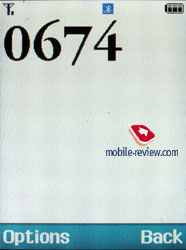
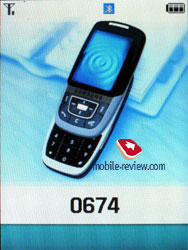

When Samsung D810 appears in the end of February, it will cost about 375-400 USD, which is quite expensive for this solution. The market is filled with close products, which often can boast with even more functions and a memory card. An attempt to create a copy of the RAZR fails from the very beginning, for all such products are secondary and can't achieve amazing sale. We see no special sense in this mode, and think that it should be treated as an assortment offer in the company's product line.
Eldar Murtazin (eldar@mobile-review.com)
Translated by Maria Mitina (maria.mitina@mobile-review.com)
Published — 31 January 2006
Have something to add?! Write us... eldar@mobile-review.com
|






























































































